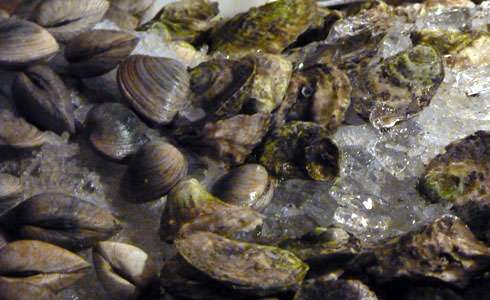

Photo by Judith Hausman
Oysters on ice waiting to be devoured.
Vicious storms made Rhode Island even smaller this year, but for a state the size of the Louisiana oil spill, Rhode Island has amazing food traditions. I won’t even tell you about the Italian part of Providence or the Portuguese communities this time.
I spent a day on the coast there recently on the way to Boston. I stopped in Narragansett, R.I., (and all up and down the Northeast Coast), where oyster are growing. In fact, aquaculture is the fastest growing farming sector in the country. This kind of urban farming means fat, briny East Coast bivalves are being raised just offshore of wide and popular Atlantic beaches, historic tourist destinations and working fishing centers, which have been shrunk by regulation and depleted oceans.
Gourmet Glossary
Mignonette: A traditional oyster dipping sauce sherry vinegar, white wine and minced shallots
Quahog: Large, hard-shelled clams
Cedar Point Oysters are growing as far south as Norwalk, Conn., a suburban commuter town. Historic Mystic and Stonington, Conn., the sound between Block Island, R.I., and Shelter Island, N.Y., and the mainland are producing expanding crops of wonderful oysters. Pipers Cove, Briarpatch, Milford, Fishers Island and Pine Island oyster farms are booming in these more southerly Atlantic deep waters that stay slightly less icy than farther north, thus extending the gathering season.
Here’s how Bina Venkataraman of The Boston Globe explained oyster farming in January 2009:
“In 1996, Rhode Island had only six oyster farms on nine acres. Today, it has 30 farms spanning more than 120 acres. While this pales in comparison with the industry’s more than 20,000 acres of state waters at its peak in the early 20th century, the value of oyster farming, now over $1 million, has grown an average of 10 percent each year for the last several years.
Oyster farmers lease underwater tracts from the state, and construct grids of mesh bags roped together. They buy oyster seeds, as small as grains of sand, and plant them in bins near their docks. When the oysters have reached nearly an inch in size, the growers transfer them into the bags in deeper water, then typically wait two to three years before harvesting the shellfish.”

Photo by Judith Hausman
Oyster shooters: Oysters in a shot of vodka.
We tried our best to eat a few (dozen) at Matanuck Oyster Farm’s restaurant that Friday night, to no avail. It was still too chilly to sit outside overlooking the salt marsh, even with heaters, and inside behind the chipped ice, the shucker was so busy prying the oysters open that he moved like a seven-armed god. Even if they aren’t aphrodisiacs, the crowd was packed three deep at the bar to get at them. Some of the oysters went into shots of vodka to make oyster shooters. I’d rather just a dip of mignonette.
I came late to an oyster passion, but I adore them now. Yes, grilled or stuffed or battered and fried, but I like them best neat. To me they are like eating the sea; I throw back my head and slide their elemental flavor into my mouth. I prefer East Coast bivalves like these, which are more briny and less creamy than the popular West Coast Kumamoto, for example.
Places in Rhode Island with Native American-inspired names like Weekapaug, Misquammacutt, Papaquinapaug and Usquebaug are common, and some of the oysters bear similar names, like the Matanucks and the Ninigrets. That night, though, even the Salt Ponds and the East Beach Blonds sadly went untasted. Instead, we had to pack it in and head for Wiley’s, a luncheonette in Narragansett that opens only on weekend evenings and that also proudly serves local seafood in a modest setting.

Photo by Judith Hausman
The crowded oyster bar.
New England clam chowder (from chaudiere, French for the big iron soup pot) came first: creamy but not heavy, full of clams and potatoes, though this wasn’t Rhode Island’s very own version, which is clear, not creamy and, of course, not with sacrilegious tomatoes. That’s Manhattan’s style. Local flounder in butter sauce and a pile of homemade, horseradish-spiked cole slaw saved the meal. We didn’t have room for the “stuffies,” the Rhode Island name for over-stuffed quahog clams.
If we had gone out to breakfast the next morning, I would have looked for johnnycakes, another Rhode Island specialty. The name originated in journey cakes, since they traveled well in saddlebags. A very small crop of real white cap flint corn is still grown on small farms in these parts. The stone-ground cornmeal is mixed with water and maybe a tiny bit of fat, and the thin batter is poured on a griddle. The trick is not to touch them for about 7 minutes. When they are good and hard, they flip easily. Otherwise they are a gooey mess. The taste of corn comes through purely, especially with real maple syrup, which is made all over New England and Upstate N.Y., not only in Vermont.
Next time … and we’ll take a swim then, too.




